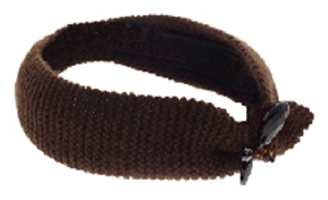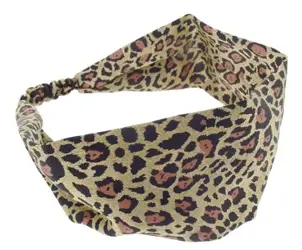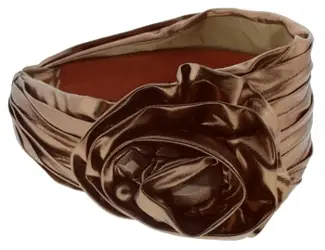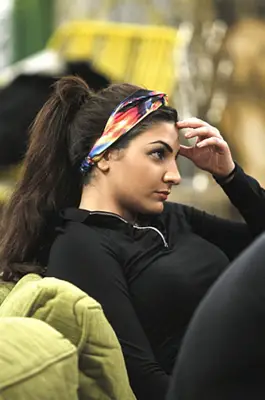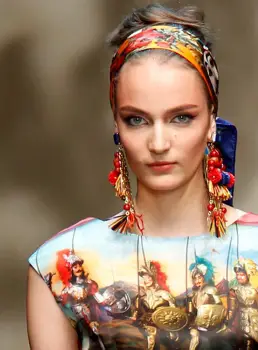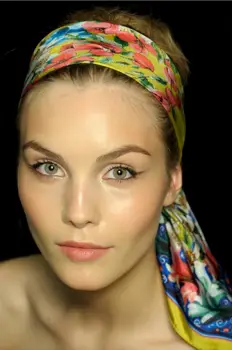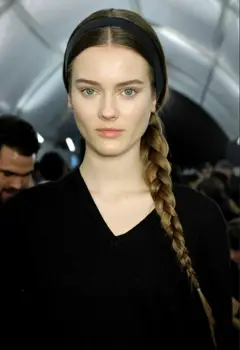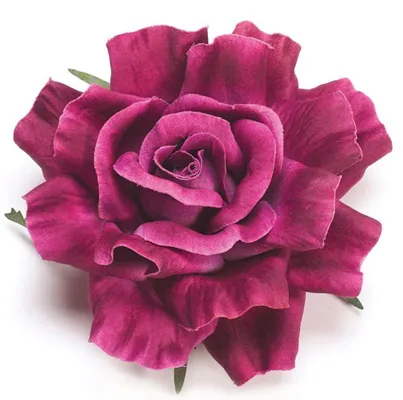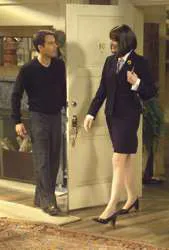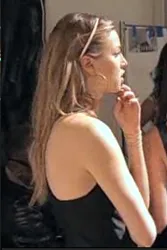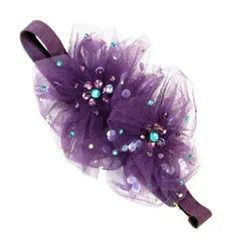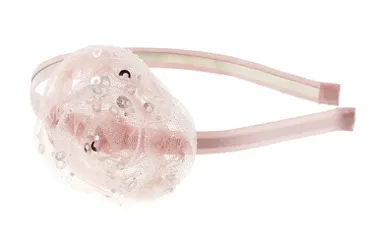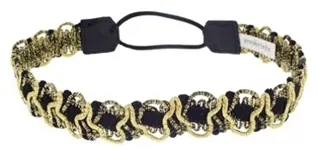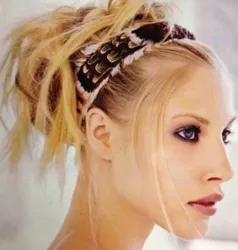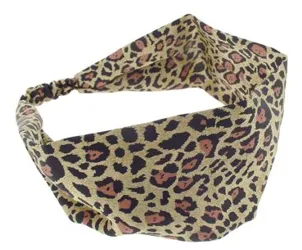
Headband Fabrics
Headband FabricsHistorically headbands are created from U shaped hard materials (metal, cellulose, wire, plastic or similar) or an array of soft materials fashioned into bandeaus, headscarves or turbans.
Headband fabrics or cloth might consist of everything from expensive cashmere and silks to an array of synthetic fabrics including polyester, acrylics and nylon fibers.
Textile Versus Cloth
Textile refers to any material made of interlacing fibers.
A textile or cloth is a flexible woven material consisting of a network of artificial fibers often referred to as thread or yarn.
Yarn is produced by raw fibers of wool, flax, cotton, spinning or other material to produce long strands. Textiles are formed by weaving, knitting, crocheting, knotting or pressing the fibers together.
Fabric Versus Cloth
The words fabric and cloth are used in textile assembly trades (such as dress making, tailoring and hair accessory making) as synonyms for textile. However, there are subtle differences in these terms in specialized usage.
Fabric refers to any material made through weaving, knitting, spreading, crocheting, or bonding that may be used in production of further goods (garments, etc.).
Cloth may be used synonymously with fabric, but often refers to a finished piece of fabric used for a specific purpose (e.g., table cloth).
List Of Types Of Headband Fabrics
Listed below are some, but not necessarily all, the types of headband fabrics:
Bouclé - Both a yarn and a fabric made from it. The yarn is made from a length of loops of similar size which can range from tiny circlets to large curls.
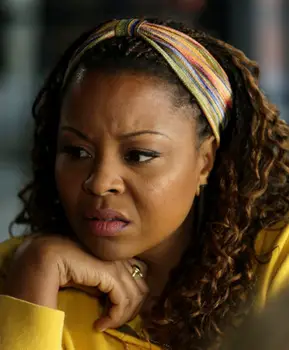 Tymberlee Hill Wearing Soft Knit Headwrap as Kay on Marry Me - (Photo by: Chris Haston/NBC) 2014 NBCUniversal Media, LLC
Tymberlee Hill Wearing Soft Knit Headwrap as Kay on Marry Me - (Photo by: Chris Haston/NBC) 2014 NBCUniversal Media, LLCTo make bouclé, at least two strands are combined, with the tension on one strand being much looser than the other as it is being plied, with the loose strand forming the loops and the other strand as the anchor.
Bouclé is also the name of the fabric made from this type of yarn, especially fabric that maintains the looped appearance. Soft headbands made of Bouclé have been popular in the past.
Cashmere - Made from the hair of the Indian cashmere goat and mohair, the hair of the North African angora goat. Types of wool known for their softness.
Charmeuse - A lightweight fabric woven with a satin weave, in which the warp threads cross over three or more of the backing (weft) threads.
The front of the fabric has a satin finish—lustrous and reflective—whereas the back has a dull finish.
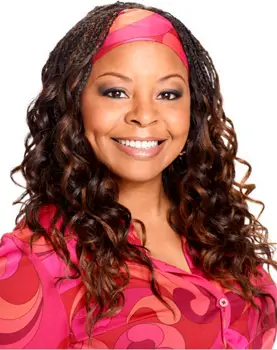 Tymberlee Hill as Kay on Marry Me Wearing Soft Headwrap - (Photo by: Chris Haston/NBC)
Tymberlee Hill as Kay on Marry Me Wearing Soft Headwrap - (Photo by: Chris Haston/NBC)Tuesdays on NBC (9-9:30 p.m. ET) -
2014 NBCUniversal Media, LLC
It can be made of silk or a synthetic lookalike such as polyester. Silk charmeuse is more expensive and delicate. It's softer and a better insulator.
Polyester charmeuse is less expensive than silk and may withstand machine washing. Unfortunately it doesn't breathe as well as silk.
Charmeuse differs from plain satin in that charmeuse is softer and lighter in weight.
Crepe - A matte fabric with a textured finish that is very finely wrinkled. Washes and wears well year-round. A good choice for blouses and skirts.
Cotton - Cotton is comfortable year-round because it's a vegetable fiber. Cotton is often mixed with a synthetic fiber to reduce wrinkling and increase wear.
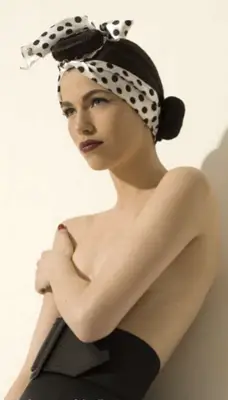 Soft Headwrap - Boardwalk Buns - Jason Kearns - Art Direction: Jason Kearns of Kearns
Soft Headwrap - Boardwalk Buns - Jason Kearns - Art Direction: Jason Kearns of KearnsDavidson Hair and Skin Care - Makeup: Hanoch - Styling: Lorraine Langlois
Photographer: Richard Dubois - Model - Next Canada
Crocheted Materials - Fabric created from the interlocking of yarn, thread or other materials using a crochet hook. Crocheted headbands are very popular in some fashion circles.
Delicate interlinked chains - Often an intricate design of interlinked chains are strung with an array of beads, crystals, rhinestones, sequins pailettes, flowers or similar embellishments. The chains are often connected to one or more elasticized bands which stretch for an easy custom fit.
Gabardine - A closely-woven fabric with definite ridges, this fabric is made in either cotton, wool or rayon. Garbardine is expensive, but fairly wrinkle-free. It also wears well year-round.
Hemp - A fiber or a blend of fiber used in hair accessories such as headbands, headwraps and/or soft turbans. Similar to cotton, flax, jute, bamboo and ramie. Nettles are sometimes used to create fabrics similar to hemp or flax.
Jersey - A tightly-woven, lightweight fabric made from wool, rayon, or man-made fibers. Can often be machine-washed and wrinkle-free if laundered appropriately. This is a good choice for headbands, wraps and turbans which are best when made from wrinkle free fabrics.
Knitted Materials - Similar to crocheted materials, knitted materials involves the interlocking of loops of yarn, thread or similar. Lightweight knits are popular for use in headwraps which are often designed with elasticized sides or back for an easy custom fit.
Lace - A delicate fabric made of yarn or thread in an open web pattern made by machine or hand. Historically linen, silk, gold or silver threads have been used to create lace.
In current times lace is often made from cotton thread. Sometimes it's still made from linen and silk threads.
Leather - Technically not a true fabric, leather is considered the oldest material used for clothing. Real leather is created from an animal or reptile. Some people refuse to wear real leather derived hair accessories due to concerns over animal rights. Faux leather is much more affordable and popular for soft head wraps.
Paillette - Small shiny objects (as spangles) applied in clusters as a decorative trimming on headbands or similar hair accessories. In some cases paillettes will utilize a heavy fabric base for structure.
Satin - A weave with a traditionally glossy surface and a dull back. Satin weave is usually characterized by four or more cool fill or weft yarns floating over a warp yarn. Optionally it's four warp yarns floating over a single weft yarn.
The satin may or may not have a lining. Some linings might be contrast colors. They may be partnered with elastic sides or back.
Silk - Traditionally silk is cultivated from silkworms and is a very fine yet strong fibers. Pure silk requires gentle care and is not recommended for everyday wear.
Silk blends wear better and work better for some types of head scarves. Washable silk is very popular in some hair accessory circles because it can be machine-washed.
Synthetic Fibers - Synthetic fibers used to mean scratch, shiny polyester, but advances in fiber technology have led to better, more wearable fibers.
A blend of natural and synthetic fibers takes the best qualities of each to create natural-feeling fabrics that are durable.
Synthetic Lace - A form of lace can also be created from synthetic fiber. Custom lace can be made from copper or silver wires instead of thread.
The look of delicate floral lace printed onto a sturdier knit fabric is sometimes utilized to provide the look of lace with the practical wearability of knit.
Taffeta - A crisp, smooth, plain twisted woven fabric made from silk or a combination of rayons. It's considered a "high-end" fabric, suitable for use in more formal fashions.
It yields a more starched-like type of cloth which holds its shape better than many other fabrics. Extremely thin, crisp type of taffeta is called paper taffeta. It's not as popular for soft headband fashions.
Thread - A type of yarn intended for sewing by hand or machine. Modern manufactured sewing threads may be finished with wax or similar lubricants to withstand the general wear and tear of sewing.
Threads designed for embroidery are specifically designed for hand or machine embroidery. They may be cotton, wool, fiber or similar filaments.
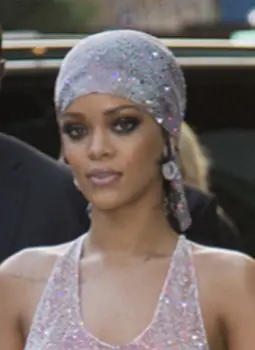 Rihanna Wearing Crystal Encrusted Soft Headwrap - Attending 2014 CFDA Awards in New York City - 06/02/2014 - Outside Arrivals - MJ Photos / PRPhotos.com
Rihanna Wearing Crystal Encrusted Soft Headwrap - Attending 2014 CFDA Awards in New York City - 06/02/2014 - Outside Arrivals - MJ Photos / PRPhotos.comTweed - A coarse wool fabric woven with a mix off colors, tweed holds it shape well, but usually must be dry-cleaned. Best for jackets, vests, and slacks.
Velvet - is a type of woven tufted fabric in which the cut threads are evenly distributed, with a short dense pile, giving it a distinctive feel.
By extension, the word velvety means "smooth like velvet." Velvet can be made from either synthetic or natural fibers.
Wool - An animal fiber, wool is made from different animal fleeces to create different fabrics such as cashmere, camel hair, and angora. Often mixed with other fibers such as cotton.
Good wool is wrinkle-resistant, wears well and will hold its shape if cared properly.
Yarn - A long continuous length of interlocked fibers, suitable for use in the production of textiles, sewing, crocheting, knitting weaving, embroidery and/or rope making.
Headband Fabrics - Synthetic Textiles
Many different types of synthetic textures are used in headbands, headwraps, turbans and related hair accessories to imitate more expensive and/or exotic fabrics.
Polyester fiber is used in many types of hair accessories, either alone or blended with other fibers such as cotton. Acrylic is used to imitate wools, including cashmere.
Nylon is a fiber used to imitate silk. Polyurethane products made by the trade name of Lycra (Spandex) are also sometimes utilized in whole or part.
Summary - Headband Fabrics
Headbands, headwraps, turbans or similar hair accessories which utilize soft fabrics may utilize a wide range of textiles. Soft headbands or wraps might be made with silk, satin, lace, wool or an array of knitted fabrics.
Synthetic textiles have become very popular due to their inexpensive options.Social Media Network Information
Please follow us on Twitter at: https://Twitter.com/HairBoutique. I look forward to meeting new people from all walks of Twitter and learning from their Tweets.


